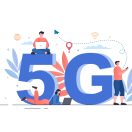The constantly-changing work culture and lifestyle of the urban mass are significantly wavering its priorities and requirements. People, these days, have more disposable income, but less time to invest in things that are not money-making. Hence, when it comes to issues related to purchasing, after-sales service, product/service information, etc., customers look for personalized and prompt customer support across multiple channels. Today, customers are spoiled with options. If they don’t get their issues resolved on time, due to the company’s inefficient customer support service, they don’t think twice before switching to their competitors. Hence, a company must have an augmented customer support system in place to retain existing customers and gain more loyal customers. Business owners, these days, often outsource the customer support service to contact centers to get a 360-degree view of the entire customer journey and ensure optimum customer retention.
Cutting-edge customer support technologies being adopted by contact centers :
- Convenience
Interactive Voice Response (IVR) technology and intelligent routing.
IVR is a telephony software technology commonly used by contact centers and call centers to interact with callers through a set of automated menus. This enables customers to resolve their problems themselves. Call routing facilities ensure smooth customer experiences. The latest intelligent routing technologies come with sturdy reporting and metrics tracking potentiality. As a result, contact centers can get a clear idea about the type of received calls, how promptly the calls are being taken, and where the calls are being deflected.
- Artificial Intelligence(AI) and Machine Learning.
Robotic Process Automation (RPA), AI, and machine learning have immensely contributed to the evident transformation of customer care service. Today, chatbots make the work of human agents easier. 24×7 active, live chatbots solve various generic queries of customers and pass the complex issues to the human executives.
Tips to embrace digital transformation appropriately:
- Convenience
Contact centers need to understand that technologies and automation need to be used strategically to support human interactions and not replace them. Though customers, these days, often opt for automated and self-service options to ensure optimum time-saving, they want human interactions and find it more helpful in the case of complicated and non-generic issues. For example, AI-powered chatbots can be introduced to merely deal with general questions and FAQs. But, the complex issues should be transferred to the human executives, who can resolve them better with a personal touch. Meaningful conversations between support executives and customers can build personal connections, which are the key to building loyal customers. Therefore, new-age technologies should be used to expedite these relationships.
- Digital transformation is bringing a fundamental change to the customer support operation. Hence, contact centers looking to embrace the change must decide their primary goals. Either they can be the last resort, in the case of which, customers will seek their help only when they are facing some problems that need to be resolved, or they can play active roles by observing the customers’ activities on the websites and initiating conversation, through live chats, accordingly.
- Contact centers that have implemented the latest technology and introduced new digital channels like live chat, web calling, video chats, etc. must understand that not all customers have the same psyche and preferences. The older generation usually prefers telephonic conversations, the millennials prefer text-based communications like live web chats and the younger generation is more inclined towards video-based communication. Hence, contact centers must first get a clear idea about the primary customers of a company and then decide on the channel/s accordingly.
- Training customer support agents to use the latest technology appropriately is a must. The communication style and throw of words often vary with different digital channels. Customer support executives must learn how to utilize the digital tools best to ensure maximum customer acquisition and retention. Also, contact centers must roughly calculate the number of expected interactions in a day and assign staff accordingly.
- The concept of omnichannel support is introduced, primarily, to make sure customers can effortlessly switch from one channel to the other. In this case, all the digital channels are synced with each other. As a result, a customer, who started conversing on a live chat can quickly jump to a phone call and continue the same conversation there. Therefore, contact centers need to make sure all teams assigned to different channels have access to the same information.
- The data acquired by the contact centers using technological tools must be used aptly. Customer journey mapping technology can be utilized to understand the primary issues faced by the maximum number of customers visiting the website. This information will help the contact centers to get an idea about which all sections of the website or services need improvements.
- By observing the customers’ recent purchases, contact centers can automate chat interactions and provide relevant information before they ask for it. The customers often reply with further queries, if they have any.
Summary
Due to the rapid advancement of technology, contact centers are going through a digital transformation, which has brought in the concept of omnichannel support. Today, digital technologies are optimized to deviate calls, gain customer insights, offer personalized services, etc. Cloud-based contact centers get access to customer feedback from social media, voice calls, email, SMS/MMS, IVR, etc. from a single console. These data are analyzed to get a clear understanding of customers’ psyche, purchasing habits, choices, etc., and also stay updated on all the transactions the customers make and the channels they use. This helps the contact centers to offer relevant and personalized support to the customers and resolve their issues better.



